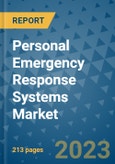Market Insights
Over the past several years, personal emergency response systems have become increasingly integral to healthcare support, particularly for elderly and at-risk populations. The demand is soaring due to the proliferation of wearable medical devices, smartphone-based applications, and enhanced emergency communication capabilities. As technology becomes more user-friendly and widely adopted, the market is witnessing a shift from traditional landline-based systems to mobile and app-integrated solutions.Key manufacturers are prioritizing product development in response to changing user demands, including wireless connectivity, cloud-based data integration, real-time GPS tracking, and automatic fall detection. These innovations offer enhanced mobility, faster response times, and higher safety standards.
Market Drivers
The market is largely being driven by the increasing need for high-end emergency medical care and continuous monitoring systems for the elderly. Rising disposable income and global awareness surrounding personal health and wellness have also boosted demand.Smartphone penetration has further revolutionized the industry. The adoption of mobile app-based alert systems allows users to access emergency care services directly through their phones. The convenience of installing a PERS mobile app with features such as an emergency button linked to service centers is propelling adoption rates.
Another strong driver is healthcare expenditure. Countries like the U.S. are allocating a significant portion of GDP towards healthcare infrastructure and patient safety solutions, which directly supports the market's upward trajectory.
Business Opportunity
With the convergence of technology and healthcare, companies are finding growth opportunities in producing hybrid models that offer multiple functionalities in one device. From GPS tracking to medication alerts and two-way communication, these features are being integrated into lightweight, easy-to-use devices tailored for elderly and disabled users.The emergence of reimbursement programs and government-funded insurance initiatives, particularly in developed economies, are also aiding market expansion by making these devices accessible to low-income groups.
Moreover, businesses are aggressively acquiring smaller PERS manufacturers to strengthen their portfolios, improve distribution networks, and enhance customer outreach in emerging regions.
Region Analysis
United States: The U.S. remains the dominant force in the global PERS market due to a large aging population, higher healthcare expenditure, and early adoption of innovative technologies. Growth in local R&D, increased product approvals, and investments in new healthcare technologies contribute to market dominance.United Kingdom: U.K. is gaining traction due to the increased affordability of PERS devices and the development of technologically advanced yet cost-effective solutions. Companies are focusing on personalized user management features, which has improved adoption rates.
Canada: Canada's market is evolving rapidly with the introduction of wearable technology and government-funded programs that subsidize medical alert systems for eligible individuals. Increased adoption among the elderly population and a rise in fall-related incidents are further strengthening the market.
Key Players
Several companies are shaping the competitive Analysis of the personal emergency response systems market by investing in research, introducing advanced solutions, and expanding via mergers and acquisitions. Notable players include:- Koninklijke Philips N.V
- LifeWatch USA
- Tunstall
- ADT Inc.
- Medical Guardian LLC
- MobileHelp
For instance, Philips launched the Philips Cares app and the GoSafe 2 wearable device, offering real-time tracking and emergency communication in one compact solution. Tunstall expanded its connected health portfolio through strategic acquisitions, enhancing its ability to deliver integrated telecare and telehealth services.
Segmentation
By Product:
- Landline Devices
- Mobile Devices
- Standalone Devices
- Mobile Apps
By End User:
- Home-Based Users
- Assisted Living Facilities
- Hospitals
By Region:
- North America
- Latin America
- Europe
- Asia Pacific
- Oceania
- Middle East and Africa
This product will be delivered within 1-3 business days.
Table of Contents
Companies Mentioned
- Koninklijke Philips N.V
- LifeWatch USA
- Tunstall
- ADT Inc.
- Medical Guardian LLC
- MobileHelp








